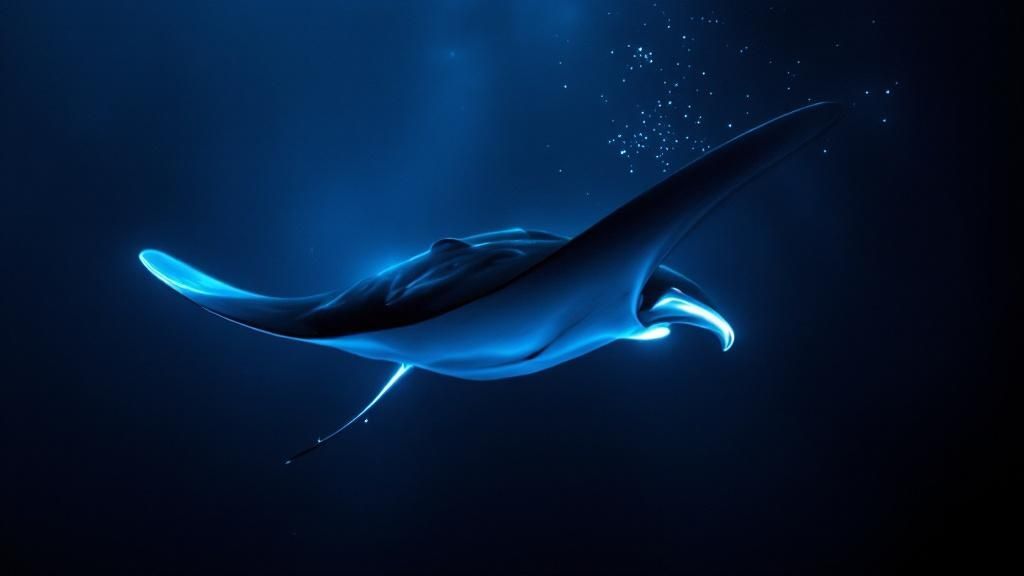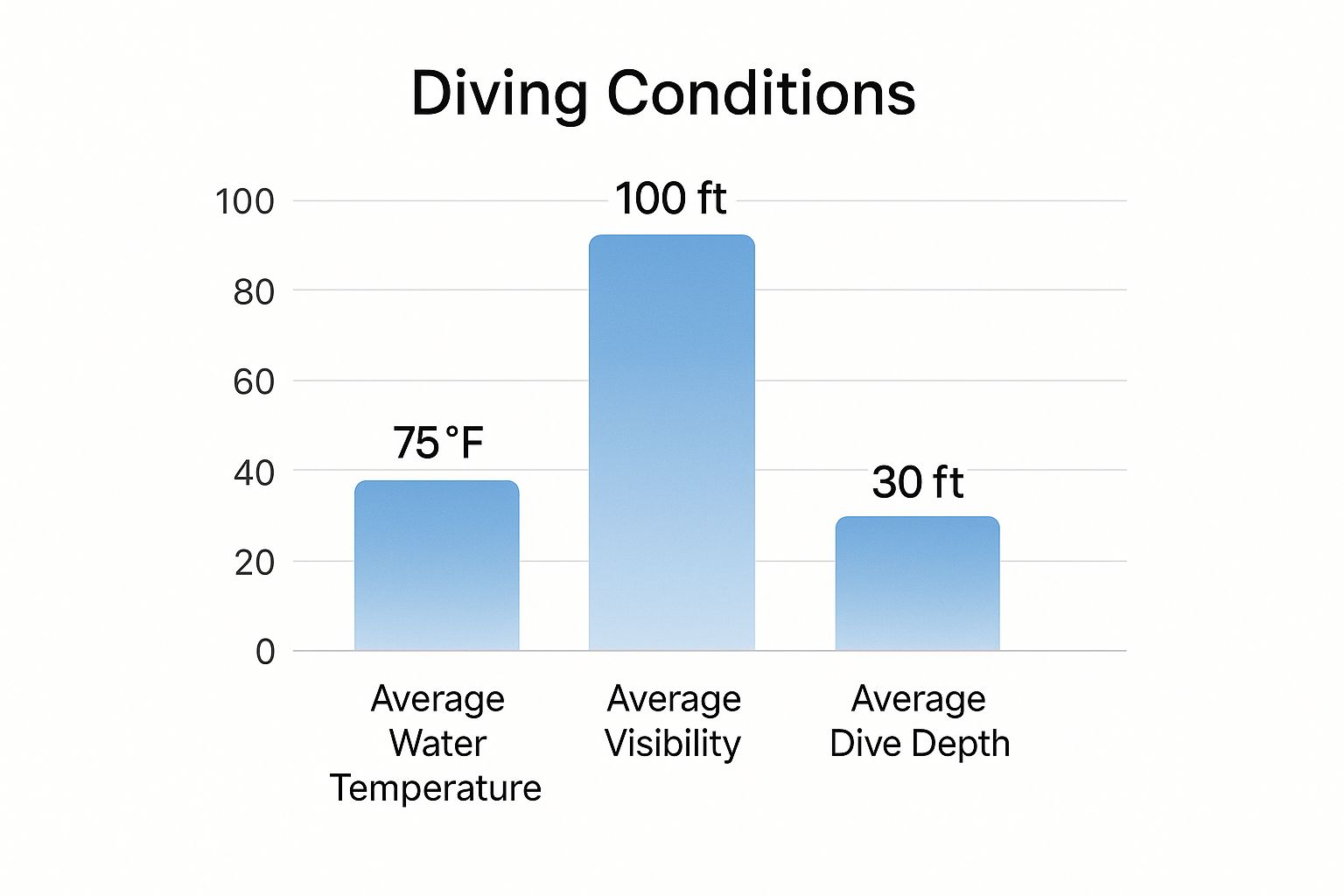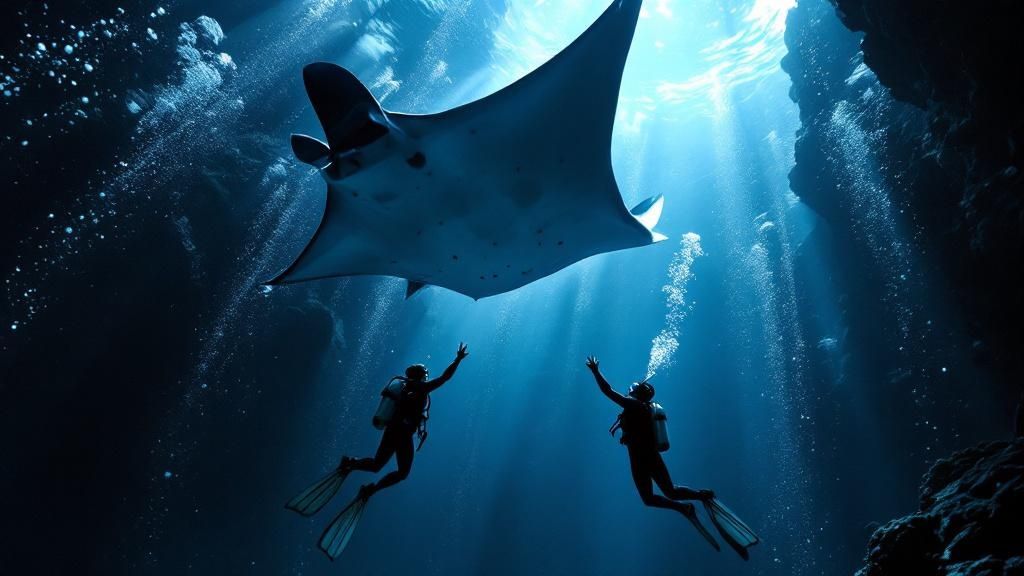Why Kona's Manta Ray Night Dives Are Pure Magic
Floating in the dark Pacific, with these gentle giants gliding just inches from your face… it's an experience that's hard to put into words. I've done dozens of these dives, and I still get chills thinking back to my first time seeing a manta ray doing its underwater dance in the beams of our dive lights. There's something truly special about Kona's waters. The way the underwater landscape is formed creates these concentrated feeding zones packed with plankton, making manta ray encounters incredibly reliable.
This reliability is what truly sets Kona apart. We're talking an 85-90% success rate for manta ray sightings. That's practically unheard of in most dive destinations. In fact, the Kailua Kona area, and the Kona Coast in particular, is known for this incredibly high success rate. Discover more insights. This consistency lets you really soak in the magic of the experience, instead of stressing about whether you'll even see a manta. For even more info, check out our guide on manta ray night dive kailua kona.
The magic happens all year round, too, although each season has its own unique perks. Winter often means calmer seas and amazing visibility, while summer can surprise you with larger groups of feeding mantas. Imagine being surrounded by a dozen of these gentle giants, each with a wingspan wider than a car!
The Unique Allure of Kona’s Manta Rays
What always gets me is how even the most experienced divers, the ones with thousands of dives under their belts, are completely mesmerized by these graceful creatures. It’s like watching a slow-motion ballet, performed under a spotlight of plankton and light. Kona’s volcanic coastline, the nutrient-rich currents, and the protected bays all come together to create the perfect conditions—conditions you just won't find anywhere else.

Why This Dive Is Different
This isn’t your average night dive; it's stepping into a completely different world. It’s about witnessing the raw power and incredible grace of these amazing animals in their natural habitat. It's about sharing the wonder of something truly extraordinary, something you'll remember long after you resurface. This unique experience is what makes a manta ray night dive in Kailua Kona a must-do for anyone who loves the ocean.
Finding The Right Tour Operator (It Really Matters)
Let's be honest: choosing a manta ray tour operator in Kona can make or break your experience. I've been there – from incredible encounters to feeling like I was in a crowded swimming pool with mantas. After years of diving with different companies in Kailua Kona, I've learned exactly what to look for (and what to avoid).
Group size is key. A boat crammed with 20+ people jostling for a view? No thanks. The magic happens in smaller, more intimate groups where the dive masters can give you personalized attention and tips on the best viewing spots. I once had a dive master point out a tiny baby manta hiding under its mother – something I would have completely missed in a larger group.
Don't be afraid to ask questions! Grill potential operators about their safety procedures, how often they service their equipment, and their dive masters' certifications. Vague answers about cancellations, dodging questions about group size, or a general vibe of prioritizing profit over experience? Those are all red flags. The conversation should feel like you're getting valuable information, not a hard sell.

The infographic above gives you a snapshot of average conditions during a manta ray night dive in Kailua Kona, showing the typical water temperature, visibility, and dive depth. Warm water and fantastic visibility make for ideal manta spotting!
Booking timing is another consideration. Peak season means more people, but the conditions are usually optimal. Shoulder seasons offer a quieter experience, though manta sightings might be a tad less predictable. And don't just focus on the price tag. Think about what's included, the boat's condition, and whether the operator emphasizes responsible diving practices and manta ray conservation. Manta ray night dives are hugely popular in Kona, attracting roughly 80,000 people each year. Discover more insights.
To help you navigate the options, I've put together a comparison of a few popular operators. This table highlights what I consider key factors in choosing the best fit for your manta ray adventure.
Kona Manta Ray Tour Operator Comparison
Side-by-side comparison of top-rated manta ray tour operators including pricing, group sizes, equipment quality, and success rates.
| Operator | Group Size | Price Range | Equipment Quality | Success Rate | Special Features |
|---|---|---|---|---|---|
| Kona Honu Divers | 6-8 | $150-$200 | Excellent | Very High | Small groups, personalized service |
| Big Island Divers | 10-12 | $120-$180 | Good | High | Focus on photography |
| Manta Ray Dives of Hawaii | 15-20 | $100-$150 | Average | Moderate | Budget-friendly option |
| Jack's Diving Locker | 8-10 | $160-$220 | Excellent | Very High | Experienced guides, longer dive times |
As you can see, each operator offers a slightly different experience. Choosing the right one comes down to your priorities, whether that's a small group, top-notch equipment, or staying within a certain budget.
For even more tips on picking the right dive shop, check out this helpful guide: How To Choose A Kona Dive Shop. Trust me, choosing the right tour operator truly makes all the difference. It's an investment in an unforgettable memory.
Gear Up Right For Your Night Dive Adventure
Prepping for a manta ray night dive in Kailua Kona goes beyond just throwing your mask and fins in a bag. It's about making sure you're comfortable and ready to soak in this amazing experience. Honestly, the right gear can be the difference between a magical memory and a chilly, uncomfortable night you'd rather forget.
Even though Hawaiian waters are generally pretty warm, floating for 45 minutes at night requires more thermal protection than you might think. A 3mm wetsuit is usually the sweet spot. It’s thick enough to keep you cozy without hindering your movement as you watch the mantas do their thing. Most operators provide basic gear, but there are a few things you'll want to bring yourself.
Essential Gear Checklist For Maximum Comfort
A well-fitting mask is absolutely essential. You'll be wearing it for a long time, gazing up at the lights and the mantas circling above. A leaky seal or a pinch on your nose can really ruin the moment.
- Mask: Make sure it fits snugly and doesn't leak. Test it out beforehand!
- Wetsuit: A 3mm thickness is generally perfect for Kona's water temperatures.
- Fins: Choose a pair that are both comfortable and efficient for maneuvering.
And if you're planning on snapping some photos of those incredible manta rays, don't just bring your underwater camera and cross your fingers. Practice with your camera settings in low-light conditions before you go. I've seen plenty of first-time underwater photographers get disappointed with blurry or dark photos. Knowing your equipment's limitations in these unique bioluminescent conditions is key. For more detailed gear recommendations, check out this helpful guide: The Gear You Will Need For Your Kona Diving Adventure.
Preparing Your Body and Mind
Getting ready for this adventure isn't just about the physical gear. Preparing your body and mind is important too. If you're prone to seasickness, natural ginger supplements can be a lifesaver. They're often more effective than over-the-counter meds that can make you drowsy underwater—not ideal when you're surrounded by manta rays!
Hydration is essential, but avoid drinking tons of water right before you jump in. Trust me, that can be a major distraction. Mental preparation also plays a role. Night diving is a different experience than daytime dives. Knowing what to expect, from the darkness to the unique sensations, can calm any nerves and allow you to truly appreciate the magic of these manta ray encounters.
Inside The Dive Experience: What Really Happens
Let me set the scene for a typical manta ray night dive in Kailua Kona. Knowing the “how” behind the dive really makes the experience that much more incredible. The "campfire" technique we use isn't just randomly shining lights into the water. It's more like a carefully planned underwater ballet of light. We create these feeding stations by attracting millions of tiny plankton with powerful lights. These plankton, in turn, bring in the manta rays, creating a spectacular feeding frenzy – a true wonder of nature.
Where you position yourself in this underwater theater is really important. Experienced dive masters will guide you to form a circle on the ocean floor, about 35 feet down, with all your dive lights pointed up. This creates a concentrated column of plankton – the dinner bell for the manta rays. The real magic happens above you. Mantas glide through these light beams, performing barrel rolls and graceful loops as they feast. Want to know more about what it’s like? Check out our article on what a manta ray night dive is really like.
Up Close and Personal With Gentle Giants
What always gets me is how close they come. These curious creatures often swim within inches of you. Their massive wingspans can feel like an underwater embrace. Staying calm and still is essential when they approach. Let them lead the interaction.
Some dives are pure adrenaline rushes, with multiple mantas swirling around in a feeding frenzy. Other dives are more intimate, with a single ray spending time in the light beam, allowing you to truly appreciate their graceful movements. Every dive is unique. Make sure you have good underwater lighting! You might want to check out different types of flashlights. The 'campfire' technique, used during manta ray night dives, involves shining lights to attract plankton, which then attracts the manta rays. This creates a column of light that brings in millions of plankton. Learn more about manta ray night dives.
The Unpredictable Beauty of Each Dive
No two manta ray night dives are ever the same. Some are action-packed, while others offer quieter, more personal moments. The one thing you can always count on? Pure wonder. It's a real privilege to witness these gentle giants perform their nightly ritual. It's a powerful reminder of the ocean's beauty and the magic that lies just beneath the surface.

Safety First: Night Diving Realities You Need To Know

Night diving, especially a manta ray night dive off Kona, is an incredible experience, but it requires a healthy dose of respect and preparation. From my own dives, I can tell you that knowledge and awareness are your best friends out there. The ocean takes on a whole new personality after dark. Currents can shift, visibility changes, and those familiar daytime landmarks disappear completely.
Professional dive operators, like Kona Honu Divers, follow strict safety protocols. Understanding these protocols yourself adds another layer of security to your dive. For example, communication becomes absolutely crucial when your visibility is limited to the beam of your dive light. Stay close to your buddy and divemaster, maintain visual contact, and refresh those hand signals before you hit the water.
Weather Wisdom and Equipment Essentials
Weather that might seem perfectly diveable during the day can pose unexpected challenges at night. That's why experienced operators might cancel a dive even when conditions appear fine to an untrained eye. Trust their call; they have years of experience reading the subtle signs.
Your equipment check takes on extra importance before a night dive. Make sure your regulator is breathing easy, your BCD inflates and deflates smoothly, and your mask forms a good seal. These little checks can prevent big headaches underwater. Want to learn more about the magic of manta ray night dives? Check out this article: Why You Should Go on a Manta Ray Dive in Kona.
Listen to Your Inner Voice and Communicate
If at any point during the dive you feel uneasy, let your divemaster know immediately. There’s no shame in calling it a night if you're not feeling 100%. The ocean will be there another time. Your comfort and safety are the top priorities. This highlights the importance of choosing a reputable, experienced operator for your manta ray night dive in Kailua-Kona. They're trained to handle various situations and prioritize your well-being.
Before we go any further, let's review some key safety points. The table below covers everything from pre-dive prep to emergency procedures. It's a good reminder of the essentials for a safe and enjoyable night dive.
Manta Ray Night Dive Safety Checklist
Comprehensive safety checklist covering pre-dive preparation, underwater protocols, and emergency procedures
| Safety Category | Pre-Dive | During Dive | Emergency Response |
|---|---|---|---|
| Equipment | Check regulator, BCD, mask, dive light, and tank pressure. | Monitor air supply and depth regularly. Ensure dive light functions correctly. | Switch to backup air source if primary fails. Deploy surface marker buoy (SMB) if necessary. |
| Buddy System | Establish communication signals and stay close to buddy throughout the dive. | Maintain visual contact with buddy. Check on buddy regularly. | Stay with buddy and assist if needed. Ascend together. |
| Communication | Review hand signals with divemaster and buddy. Discuss any concerns or anxieties. | Communicate any issues or discomfort to divemaster immediately. | Use hand signals or dive light to communicate with divemaster and buddy in an emergency. |
| Environment | Check weather conditions and heed dive operator's advice. | Be aware of currents and surroundings. Avoid touching coral or marine life. | Follow divemaster's instructions in case of strong currents or other environmental hazards. |
| Health | Ensure you are physically and mentally fit to dive. | Listen to your body and end the dive if you feel uncomfortable. | Seek medical attention if necessary after surfacing. |
This checklist provides a solid foundation for a safe and enjoyable dive. Remember, a well-planned dive is a safe dive. By being prepared and aware, you can fully appreciate the wonder of a manta ray night dive.
Capturing The Moment: Photography That Actually Works
Getting stunning manta ray photos during a Kona night dive is a challenge, but definitely achievable. After plenty of blurry shots and missed opportunities myself, I've learned it's all about realistic expectations and a few simple techniques. Forget fiddling with complex camera settings; in low-light, fast-moving situations, simplicity wins. Use your underwater camera’s scene mode, if it has one, or stick with auto settings. They’ll adapt to the changing light much better than you can manually.
It's more about positioning yourself cleverly within the light beams than chasing the perfect angle. Manta rays have predictable feeding patterns, so patience is often more rewarding than frantic clicking. I've found that waiting for them to glide into your light creates the most dramatic images.
Think of it like aviation safety – preparation and awareness are key. Night diving has inherent risks; keeping important principles in mind is crucial. Check out these aviation safety tips – the mindset of preparation translates surprisingly well to diving.
Light it Up, But Not Too Much
Underwater lights are essential to attract plankton, but too much artificial light washes out the natural beauty. I've discovered that the most captivating shots often capture the mantas’ graceful silhouettes against the light columns, rather than brightly illuminating every detail. This approach creates a sense of mystery and wonder, like capturing a dream underwater.
Video vs. Stills: Embrace the Movement
Video is much more forgiving in these challenging conditions. It captures the manta rays’ fluid grace better than still photos can, beautifully documenting their unique feeding ballet. Shoot short clips rather than long continuous footage. It's easier to edit later and makes for a more dynamic final product.
The Most Important Tip of All
Remember, truly experiencing this incredible manta ray night dive in Kona is more important than snapping the "perfect" photo. Don’t spend the entire dive glued to your viewfinder. Take time to simply appreciate the magic unfolding around you. These are memories you'll cherish long after you surface. These encounters are truly special.
Making Your Manta Ray Adventure Unforgettable
Your manta ray night dive in Kona will probably be the highlight of your Hawaiian getaway. But here's the thing: you can make this already-amazing experience even better. One tip? Schedule your dive early in your trip. It often shifts your whole perspective, giving you a deeper appreciation for the islands' incredible marine life.
Trust me, the post-dive excitement is intense! So, plan for some quiet downtime afterward to just soak it all in. I've seen many divers surprised by how emotional they feel after their manta encounter – it's perfectly normal. These gentle giants have a way of really getting to you.
To make the most of your manta magic, think about combining your night dive with some daytime snorkeling. Keauhou Bay is a fantastic spot, and you might even get lucky and see mantas feeding during the day!
Another way to enhance the whole experience is by supporting local conservation efforts. Learning about the organizations dedicated to protecting these magnificent creatures and their habitat adds another layer of meaning to your dive.
Handling the Unexpected
Now, let's talk about the "what ifs." What if your dive gets canceled due to weather? First off, don't freak out! Most operators in Kona offer flexible rescheduling. In fact, sometimes a rescheduled dive lands you even better conditions. The key is to build a little wiggle room into your vacation plans.
Finally, don't keep the magic to yourself! Share your experience with your friends and family. Stories like these can inspire others to care more about ocean conservation, making your manta ray dive more impactful than just a personal memory.
Ready for some manta magic? Book your unforgettable adventure with Kona Honu Divers today!
